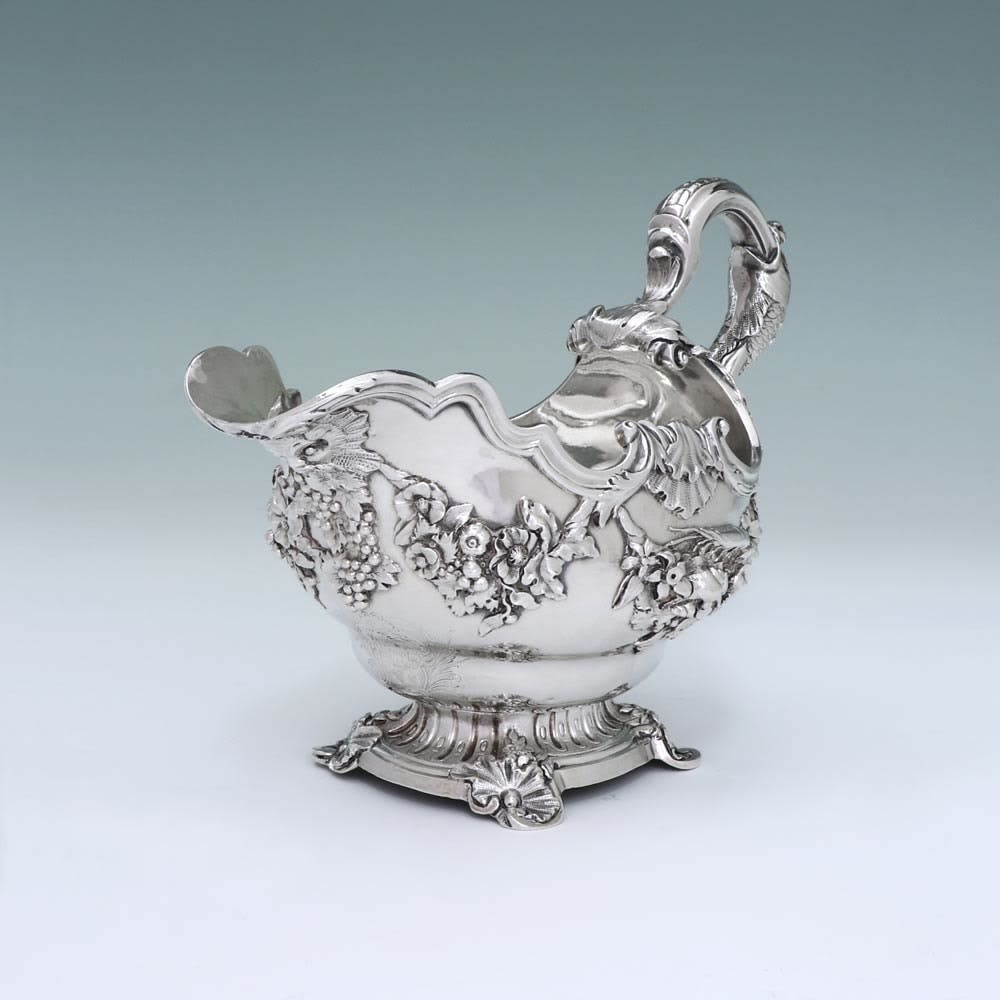





Lewis Pantin
A Pair of George II Antique English Silver Sauce Boats, c. 1738
Length: 8.5 in.
Weight: 49 oz.
London
H0457
$ 85,000.00
Further images
Lewis Pantin was almost certainly Simon Pantin's son, and by extension Elizabeth (Pantin) (Buteaux) Godfrey's uncle. Curiously, these sauceboats have no date letter. Instead they are struck with two different...
Lewis Pantin was almost certainly Simon Pantin's son, and by extension Elizabeth (Pantin) (Buteaux) Godfrey's uncle.
Both sauceboats are hallmarked, presumably in error, with an additional variant leopard's head mark in lieu of the date letter. This variant was is seen with 1738 and 1739 date letters (Jackson's page 56).
The arms are those of Harris quartering Hayne with Tuckfield in pretence for John Harris Esq (d.1767), of Hayne Co Devon, who succeeded his brother in 1718. He was Master of the Household to their Majesties George II and George III and married twice. Firstly to Margaret, daughter of Roger Tuckfield Esq. of Raddon and relict of Samuel Rolle of Heanton; and secondly to Anne, daughter of Francis (Seymour), 1st Baron Conway, whose descendants were created Marquess of Hertford.
While English pieces in the Rococo style tend to be more conservative than those found in France, Germany and Italy, the Huguenot silversmiths working in England in the early 18th century did produce works of extraordinary invention and vivacity, of which these sauceboats are a superb example.
With the dolphin handles and lobsters included in the applied swags, it’s easy to imagine these being used to serve some sort of delicious sauce over an elaborate fish dish. Indeed, the 18th century recipe book "The Cook Book of Unknown Ladies" makes reference to a sauce made using the body and ‘pea’ (egg sacks) of lobster: ‘Get some strong greavy, anchoves, shillot, nutmeg, & all spice. Set ym on ye fire together. Let ym stew a good while. Then strain it & draw a good deal of fresh butter, very thick, a glass of claret or white wine, ye body & pea of a lobster, or body of a crab. Mix all together.'
Provenance: Sotheby's London, 15 May 2003, lot 92.
Both sauceboats are hallmarked, presumably in error, with an additional variant leopard's head mark in lieu of the date letter. This variant was is seen with 1738 and 1739 date letters (Jackson's page 56).
The arms are those of Harris quartering Hayne with Tuckfield in pretence for John Harris Esq (d.1767), of Hayne Co Devon, who succeeded his brother in 1718. He was Master of the Household to their Majesties George II and George III and married twice. Firstly to Margaret, daughter of Roger Tuckfield Esq. of Raddon and relict of Samuel Rolle of Heanton; and secondly to Anne, daughter of Francis (Seymour), 1st Baron Conway, whose descendants were created Marquess of Hertford.
While English pieces in the Rococo style tend to be more conservative than those found in France, Germany and Italy, the Huguenot silversmiths working in England in the early 18th century did produce works of extraordinary invention and vivacity, of which these sauceboats are a superb example.
With the dolphin handles and lobsters included in the applied swags, it’s easy to imagine these being used to serve some sort of delicious sauce over an elaborate fish dish. Indeed, the 18th century recipe book "The Cook Book of Unknown Ladies" makes reference to a sauce made using the body and ‘pea’ (egg sacks) of lobster: ‘Get some strong greavy, anchoves, shillot, nutmeg, & all spice. Set ym on ye fire together. Let ym stew a good while. Then strain it & draw a good deal of fresh butter, very thick, a glass of claret or white wine, ye body & pea of a lobster, or body of a crab. Mix all together.'
Provenance: Sotheby's London, 15 May 2003, lot 92.





